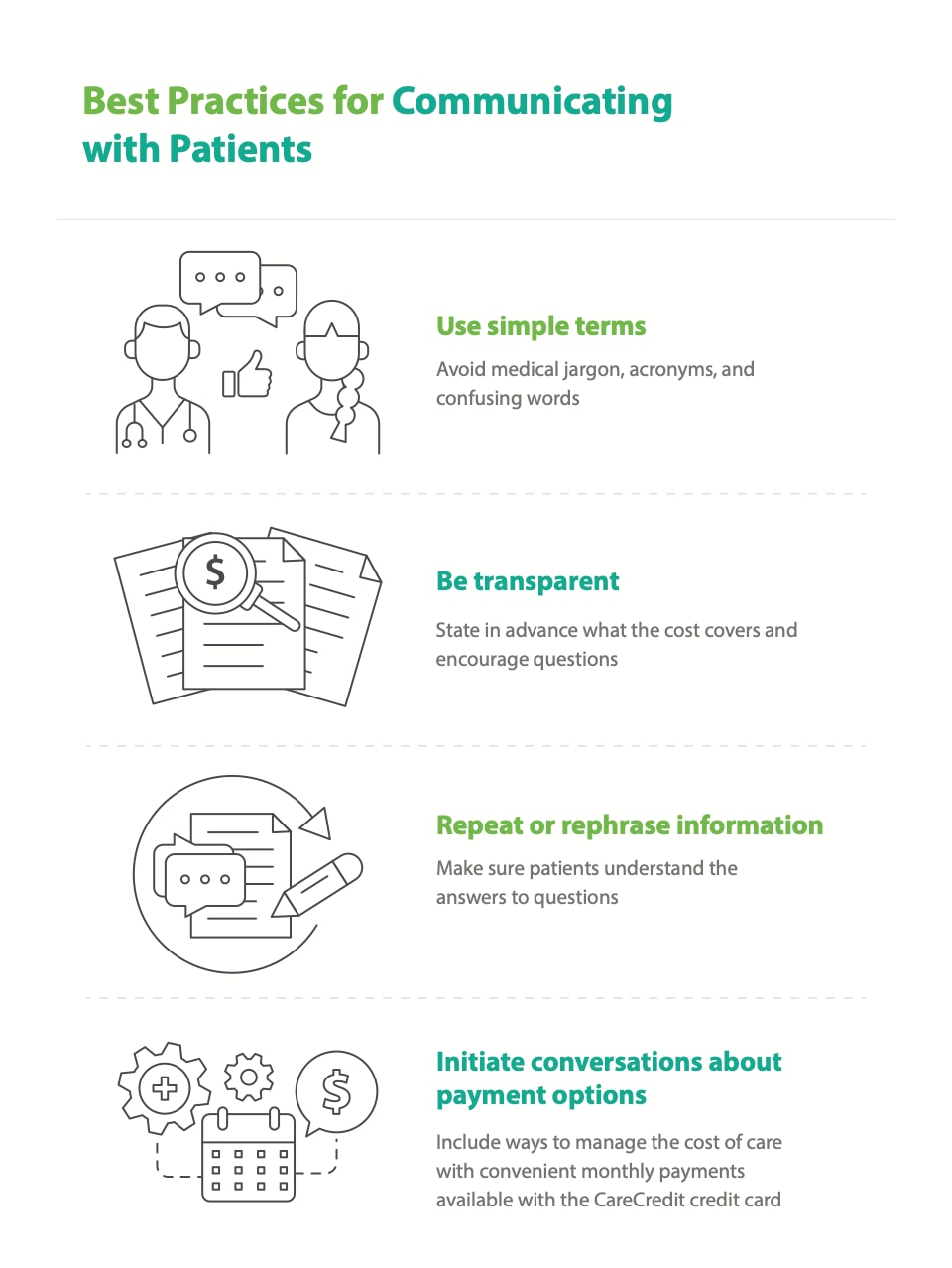How to Communicate Financial Responsibilities to Patients
Discover helpful ways to effectively communicate healthcare financial responsibilities with patients before, during and after care.
By Maureen Bonatch, M.S.N., R.N. and Michelle Seitzer
Posted Feb 07, 2025 - 6 min read

Copays, deductibles, coinsurance and out-of-pocket payments are terms healthcare workers use every day, but patients may not always understand what they mean.
Now that more significant portions of healthcare costs have become the patient’s responsibility, health systems and providers are paying more attention to the billing and payments process. That’s why it’s important to prioritize transparency and empathy around financial obligations through clear patient communication.
Clear Communication About Costs Can Help Ease Patient Concerns
Research shows that cost is at the top of the list of healthcare-related concerns among patients. A survey by The Beryl Institute found “out-of-pocket healthcare costs” ranked number one (at 42%) for healthcare issues that were most important to respondents, followed by “having affordable insurance options” (39%) and “cost of health insurance premiums" (38%).1
While providers do not have control over patients’ healthcare coverage and their level of financial responsibility, they can use clear communication to reduce uncertainty related to costs and help patients better understand their payment options.
Patients can benefit from:
- Early cost discussions
- Clear explanations of bills
- Precise accounting of out-of-pocket costs
- Discussion about additional payment methods
You can set the standard by better communicating with patients about their financial responsibilities and working to ensure they understand the billing process. Knowing how much or how to pay can help patients feel more in control. It may also improve patient retention.
12 Best Practices for Patient Financial Responsibility Conversations
It can be tricky to determine how or when to discuss the cost of care. Patients may be dealing with a chronic illness, financial hardships and/or have worries about a health diagnosis. Understanding these challenges will help your employees communicate with empathy, knowing that most patients want to be responsible for their payments and just need more information to make the right choices.
Reviewing payment options may feel uncomfortable, but it doesn’t have to be complicated. In fact, when done well, this conversation can help patients feel empowered.
Equip your employees to be an important resource and improve the patient experience by providing regular training on patient engagement strategies concerning financial responsibilities.
Leverage the use of scripts to detail how, when and what to say about patient financial responsibilities to assist employees with consumer interactions. These conversations may provide opportunities to recognize signs that a patient may benefit from financing options or a payment plan.
Here, we’ll break down practical tips for the how, what and when of clearly communicating patient financial responsibility.
4 quick tips on how to communicate
- Use simple language and try to avoid the use of medical jargon, acronyms and confusing terms.
- Be as transparent as possible, state in advance what the cost covers and encourage questions.
- Repeat or rephrase the information you provide and your answers to the patient’s questions to help ensure the patient understands.
- Explain payment options and ways to manage the cost of care, such as financing with convenient monthly payments available with the CareCredit credit card.*

4 quick tips on what to communicate
- Do your best to provide cost estimates so the patient understands and can prepare for financial obligations.
- Offer multiple payment options, such as flexible financing with convenient monthly payments available with the CareCredit credit card.*
- Explain what insurance is likely to cover and help patients consider factors such as the impact of their deductible.
- Discuss and agree upon the best approach to meet financial responsibilities.
4 quick tips on when to communicate
- Before care. When possible, provide price transparency on your website or other informational materials by listing the costs of standard services, sharing articles that clarify insurance terms or including a cost estimation calculator.
- While scheduling care. Remind patients to bring insurance cards, gently explain whether a copayment is required and ask about patients’ preferred payment method.
- During care. Display information and offer the patient a hard copy to help ensure they understand their financial responsibility before leaving the office.
- After care. Communicate with patients about their financial responsibility through various methods, such as text, phone calls, email and web portal reminders, as well as during follow-up appointments.
Ensure Effective and Accessible Patient Financial Communication
During a busy office day, it may be tempting to gather the charges required at the visit and not worry about additional costs. When you provide transparency regarding fees, it can help set expectations early on, and it allows time to respond to a patient’s questions.
Make sure employees are aware that some patients may need additional support to understand their financial responsibilities, including accessibility accommodations. Many factors may influence patients’ communication preferences, including literacy, vision, hearing deficits or having a caregiver assist with payments. Some patients may require a medical interpreter to ensure they understand responsibilities in the language they know best.
A checklist for patient communication preferences
Consider methods that can improve patient satisfaction and are responsive to their needs. Ask staff to clarify whether the patient:
- Prefers a phone call or would like to receive a physical copy of their information in the mail
- Only answers phone calls from numbers they recognize or delays checking their voicemail for days
- Can’t answer calls during their workday or doesn’t have time to wait on hold
- Wants to receive information via text messages
Texting is becoming a more popular method of patient communication. Sending and receiving a text can be more efficient than calling for both patients and employees. However, providers need to be mindful of the Telephone Consumer Protection Act (TCPA) and any state regulations that may require consent from patients before sending certain communications by text.
Build Patient Trust Through Detailed Billing Statements
When a provider clarifies healthcare terms, explains costs and practices financial transparency, it may be easier for patients to pay a bill. Patients better understand what they owe and why they owe it. When they understand the charges, they can see if the provider charged them correctly, improving their trust in their doctor.
Billing should be as predictable and clear as possible. Here are nine practical tips for streamlining patient financial communication using easy-to-understand billing statements:
- Before the visit, clarify if the patient prefers a paper, electronic or texted billing statement.
- Communicate the costs for the visit and the patient’s potential financial obligations so they are prepared for copayments.
- Review their payment options with them in advance of the visit, if possible.
- Use the same terms on the medical bill and in all communications so the patient can more easily reference their billing statement during the conversation.
- Provide information on where to view bills online, how to pay and who to call for assistance.
- Choose a large, legible font, and aim to provide concise information that includes all the necessary details needed to complete payment.
- Consider bolding, underlining and using color to ensure patients can easily identify the payment amount and due date.
- Outline charges, previous payments and insurance adjustments in columns to make it clearer how the costs were determined.
- Make payment instructions clear and easy to understand. Include a prominent contact number so patients can call and more easily resolve payment questions.
Improve Patient Communication to Boost Financial Satisfaction
You can help relieve patients' stress by communicating financial responsibilities as early as possible. Your employees can explain that there may be ways to pay for care that help them manage their budget. When you can, offer convenient monthly payments and several ways to pay to help set patients' minds at ease.
Presenting flexible payment options may improve the patient experience and reduce stress. Patients can focus more on their health and wellness and less on finances. Various options to offer include:
- The ability to manage the cost of their healthcare by paying over time or in monthly installment payments
- A payment solution with flexible financing, such as the CareCredit credit card
- A variety of payment methods, such as:
- Debit or credit card
- Website or online payment portal
- Automated payment plan or way to manage the cost of care with convenient monthly payments
- Mobile payment app with QR codes
- Self-service interactive voice response (IVR) automated phone technology
- Check
Use each interaction to gently yet directly offer the opportunity to pay a portion or all of the medical bill. Include prompts for bill payment while scheduling appointments, in automated email messages, text or voice reminders or other patient engagement strategies. Invest the time on the front end to help reduce future time spent on phone calls with patients, payment delays or missed appointments.
Why Conversations About Patient Financial Responsibility Matter
Talking to patients about their financial responsibilities can improve patient satisfaction and protect revenue. Patients want to have the same convenient, seamless billing experience they’ve become accustomed to with retailers and other services. When you can provide clear, cohesive and caring communication through confident, trained employees, patients will have the information they need and may be more likely to pay on time.
A Patient Financing Solution for Health and Wellness Providers
If you are looking for a way to connect your patients with flexible financing that empowers them to pay for the care they want and need, consider offering CareCredit as a financing solution. CareCredit allows cardholders to pay for out-of-pocket health and wellness expenses over time while helping enhance the payments process for your practice or business.
When you accept CareCredit, patients can see if they prequalify with no impact to their score, and those who apply, if approved, can take advantage of special financing on qualifying purchases.* Additionally, your practice or business will be paid directly within two business days.
Learn more about the CareCredit credit card as a patient financing solution or start the provider enrollment process by filling out this form.
Author Bios
Maureen Bonatch, M.S.N., R.N. draws from roles in nursing leadership, education and psychiatric nursing to write healthcare content. Her extensive experience in recruitment, procedural development and retention tactics contributed to the reduction of staff turnover and improvement of morale. Maureen has written or contributed to the authorship of a wide range of website articles, healthcare journals and in the creation of online educational content. She is also a prolific fiction author. Learn more about her freelance writing at CharmedType.com and her fiction books at MaureenBonatch.com
Michelle Seitzer is a freelance writer and editor with more than 15 years of experience in writing for brands and publications on healthcare, aging, caregiving and more. She is the founder of Caregiving Advice, a resource hub for caregivers of all ages.
Healthcare payment and financing solution
The CareCredit health and wellness credit card helps improve the payment experience for patients and clients, and your financial performance.
Get Started* Subject to credit approval.
The information, opinions and recommendations expressed in the article are for informational purposes only. Information has been obtained from sources generally believed to be reliable. However, because of the possibility of human or mechanical error by our sources, or any other, Synchrony and any of its affiliates, including CareCredit, (collectively, “Synchrony”) does not provide any warranty as to the accuracy, adequacy, or completeness of any information for its intended purpose or any results obtained from the use of such information. All statements and opinions in this article are the sole opinions of the author. The data presented in the article was current as of the time of writing. Please consult with your individual advisors with respect to any information presented.
© 2025 Synchrony Bank.
Sources:
1 "Consumer perspectives on patient experience in the U.S.," The Beryl Institute and Ipsos. November 2023. Retrieved from: https://theberylinstitute.org/wp-content/uploads/2023/11/TBI_PXPulse_Q3_Nov2023-Updated.pdf




